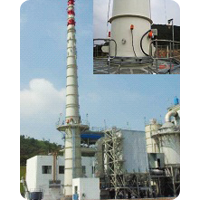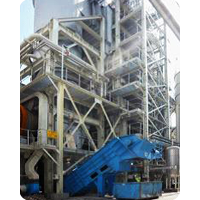-
-
-
-
Environmental
-
-
Contact Us
High-temperature incineration treatment
Ø Waste Types: Primarily handles paints, distillation residues, organic resins, organic solvents, sludge, and other types of solid, liquid, and semi-solid waste;
Ø Feed System: A total of eight feeding devices, including three solid feeding devices and five liquid feeding devices. Based on the different properties and states of the waste, various hazardous wastes are pre-treated and mixed according to compatibility before entering the incinerator through different feeding routes;
Ø Incineration System: Combining the advantages of pyrolysis gasification incineration furnaces and rotary kiln incineration furnaces, the combustion temperature can reach up to 1350℃, and the flue gas residence time in the secondary combustion chamber is >2 seconds, thus fully decomposing harmful substances; the waste heat boiler can recover and reuse most of the heat energy in the flue gas;
Ø Flue Gas Treatment System: The incinerator is designed according to the "3T" principle, using internationally advanced dioxin control technology and acidic gas purification systems, and combined with activated carbon spray adsorption for deep purification treatment to ensure that the emitted gases meet national standards;
Ø Secondary Pollutant Control: A 24-hour real-time online monitoring and analysis system is installed in the middle of the chimney to monitor more than ten indicators such as dust, SO2, NOx, and HCl in real time to ensure compliance; at the same time, the slag and fly ash produced after high-temperature incineration are subjected to TCLP testing and then sent to a hazardous waste landfill for solidification/safe landfill disposal; the wastewater produced is sent to the physicochemical wastewater workshop for treatment.


Dongjiang Environmental Protection • Veolia
Tel:4001-520-522
Email:hdv_marketing@veolia.com
Address:Nan Keng, Shiwuliao, Lianghua Town, Huichong County, Huizhou City, Guangdong Province
COOKIES
Our website uses cookies and similar technologies to personalize the advertising shown to you and to help you get the best experience on our website. For more information, see our Privacy & Cookie Policy
COOKIES
Our website uses cookies and similar technologies to personalize the advertising shown to you and to help you get the best experience on our website. For more information, see our Privacy & Cookie Policy
These cookies are necessary for basic functions such as payment. Standard cookies cannot be turned off and do not store any of your information.
These cookies collect information, such as how many people are using our site or which pages are popular, to help us improve the customer experience. Turning these cookies off will mean we can't collect information to improve your experience.
These cookies enable the website to provide enhanced functionality and personalization. They may be set by us or by third-party providers whose services we have added to our pages. If you do not allow these cookies, some or all of these services may not function properly.
These cookies help us understand what you are interested in so that we can show you relevant advertising on other websites. Turning these cookies off will mean we are unable to show you any personalized advertising.
Power by:www.300.cn |Tag | Privacy Policy



